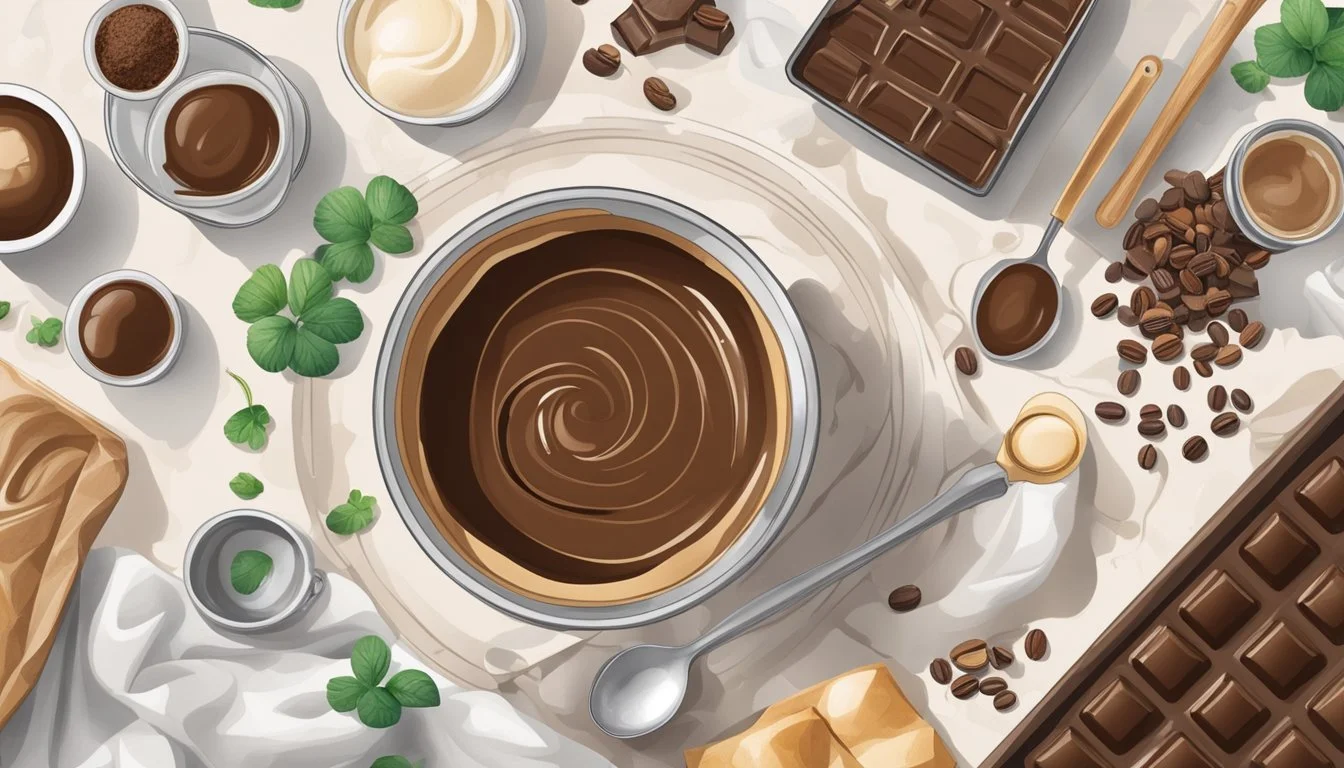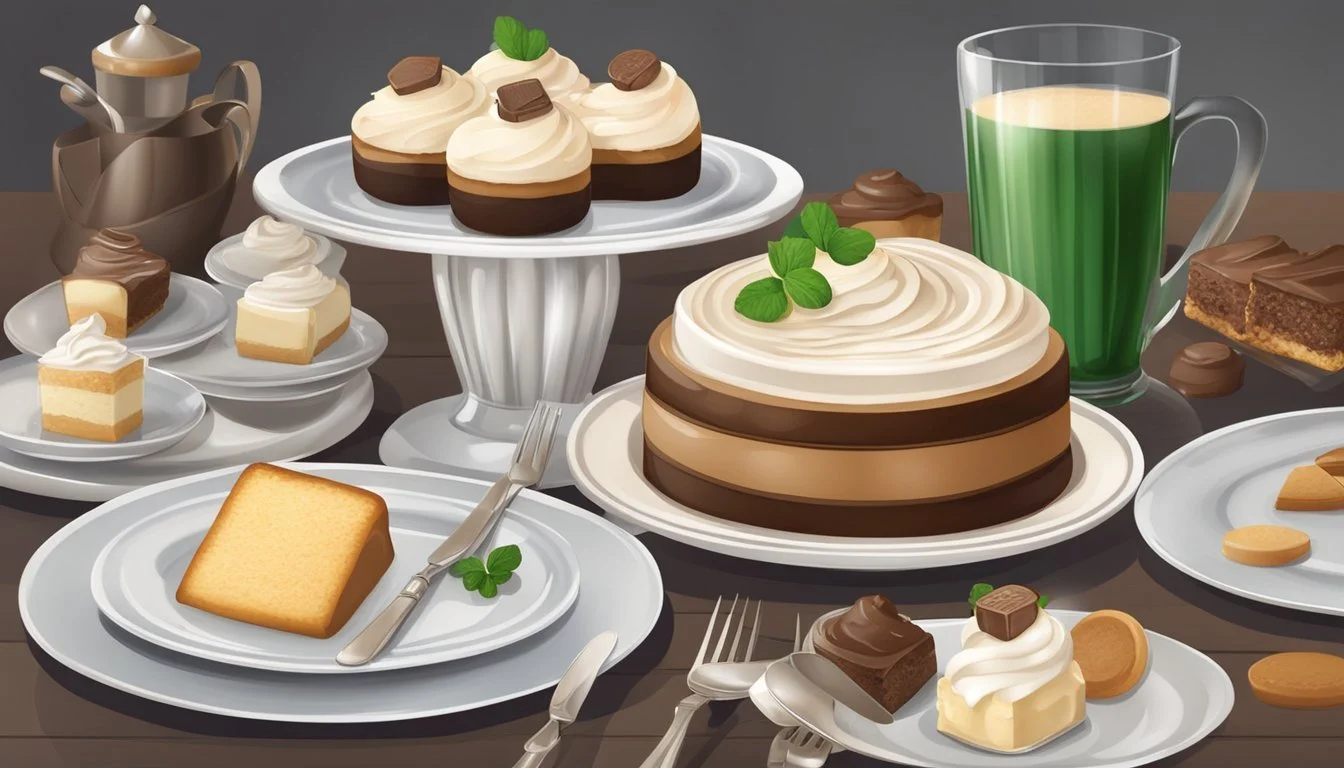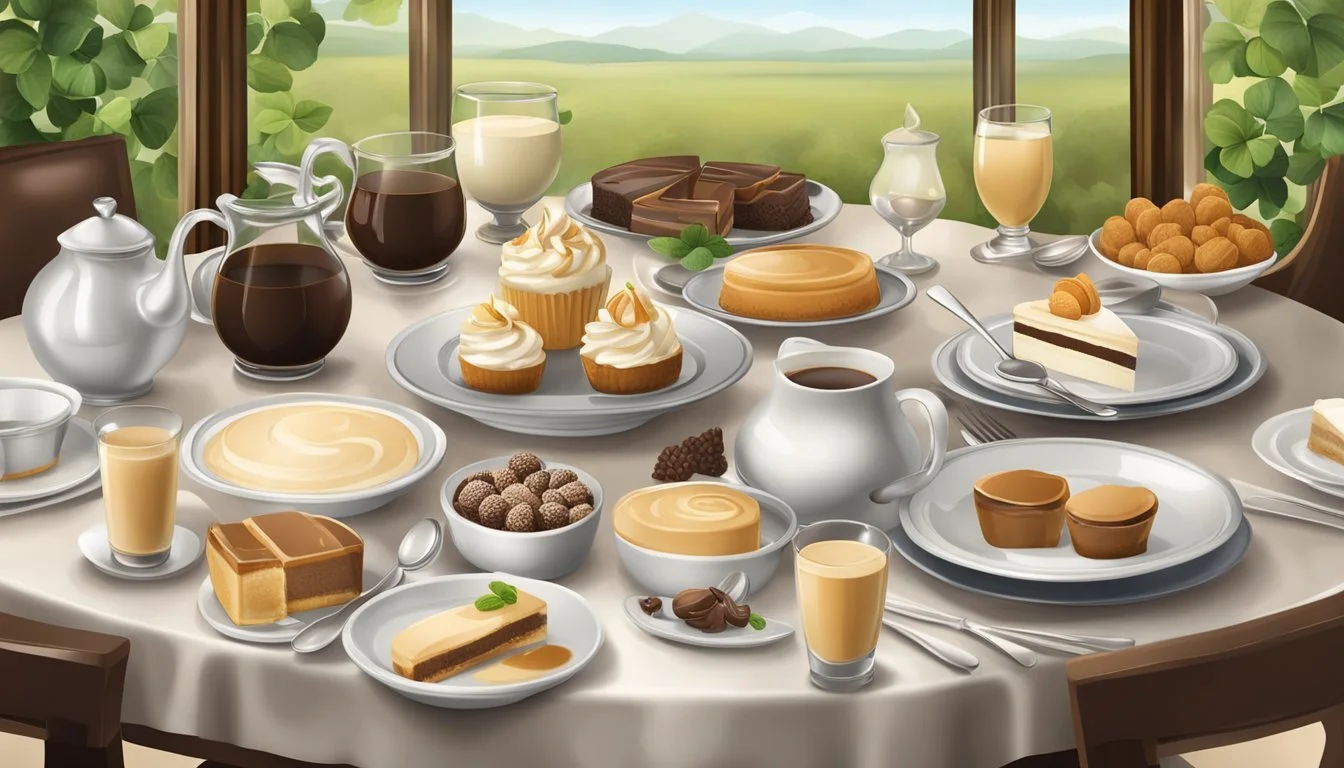How to Cook with Irish Cream for Decadent Desserts
A Guide to Indulgent Creations
Cooking with Irish cream has become a trendy and elegant way to infuse desserts (What wine goes well with desserts?) with a rich, creamy flavor that is both distinct and subtle. The liqueur, often enjoyed in coffee or on the rocks, comprises cream, Irish whiskey, and additional flavors like chocolate (What wine goes well with chocolate?) or vanilla, making it a versatile ingredient for a variety of sweet treats. From classic puddings to no-bake cheesecakes, Irish cream can transform the ordinary into the extraordinary with its harmonious blend of flavors.
When incorporating Irish cream into desserts, chefs should consider the balance of sweetness and the desired consistency of the final product. The alcohol content in the liqueur can affect the dessert's texture, especially in no-bake recipes where it contributes to setting the mixture. For example, when added to cheesecake, Irish cream imparts both flavor and a silkier texture but requires careful folding into the mix to maintain the dessert’s airy quality.
Whether experimenting with traditional recipes or crafting new concoctions, one must handle Irish cream with care to ensure that its presence enhances rather than overpowers the other ingredients. In dishes like pots de crème or Irish cream-infused chocolate sauces, the liqueur should be gently boiled and reduced to a syrupy consistency, concentrating the flavor and allowing for a more lavish integration into the dessert. With these considerations, Irish cream can elevate a simple dessert to an indulgent finale for any dining experience.
Understanding Irish Cream
Irish Cream is a versatile liqueur cherished for its creamy texture and distinctive taste, making it a popular addition to a variety of decadent desserts.
What Is Irish Cream
Irish Cream is a creamy liqueur that combines Irish whiskey with cream and other flavorings. It usually contains alcohol content ranging from 15% to 20% ABV (alcohol by volume) and is known for its rich, smooth consistency.
The Flavor Profile of Irish Cream
The flavor of Irish Cream is a complex harmony of sweet cream spiced with hints of chocolate, vanilla, and coffee. The presence of Irish whiskey infuses a subtle warmth and depth, enhancing the overall flavor profile which is both bold and nuanced.
Irish Cream in Desserts
Irish Cream is a coveted ingredient in desserts, either used as a flavor enhancer or as a key component. It adds a luxurious richness to cakes, puddings, and custards, and can also be used to create silky ganaches or incorporated into frosting and whipped creams for a kick of Irish personality.
Nutritional Information
Typically, Irish Cream is calorie-dense with a 1.5-ounce serving providing approximately 130 calories. It is high in fat, due to the cream, and contains traces of protein. It is relatively low in cholesterol, sodium, and potassium. Irish Cream does not contribute significant amounts of vitamin A, calcium, or iron and thus, should be consumed in moderation within a balanced diet.
Irish Cream Dessert Foundations
When crafting desserts with Irish Cream, understanding the building blocks is crucial for decadent results. Selecting quality components and knowing how to incorporate them effectively ensures a rich and satisfying treat.
Choosing the Right Ingredients
The success of an Irish Cream dessert begins with the selection of ingredients. One should seek out premium Irish Cream liqueur for its creamy texture and unique flavor, which combines whiskey, cream, and often cocoa and vanilla. For the supporting cast of ingredients, opt for full-fat cream cheese for its smoothness and ability to blend seamlessly with the liqueur.
The Role of Heavy Cream
Heavy cream is pivotal in achieving the luxurious texture that Irish Cream desserts are known for. It's not only used within the liqueur but also often as a separate component in recipes to add richness. When whipped, it provides volume and when used in a chocolate ganache, it creates a velvety consistency that complements the robust flavor of Irish Cream.
Working with Sugar and Sweeteners
Integrating sugar and sweeteners effectively balances the boldness of Irish Cream. One might use granulated sugar for its ability to dissolve and blend, or opt for brown sugar to add a deeper, caramel-like sweetness. Sweeteners should be used judiciously to enhance, not overpower, the complex flavors of the liqueur.
Utilizing Chocolate for Depth
Incorporating chocolate into Irish Cream desserts isn't merely for taste; it's also about adding depth and contrast. Utilizing a range of chocolate from semisweet to cocoa powder imparts varying degrees of richness and chocolate intensity, which pairs eloquently with the whiskey notes in the liqueur. Whether folded into batter or drizzled as a topping, chocolate in any form elevates the dessert's flavor profile.
Classic Irish Cream Dessert Recipes
Irish cream liqueur adds a rich and velvety dimension to desserts, infusing traditional recipes with a unique blend of whiskey, cream, and other flavors. Below are classic desserts that showcase Irish cream as a star ingredient.
Irish Cream Cheesecake
The Irish Cream Cheesecake presents a splendid fusion of creamy texture and Irish cream flavor. One starts with a crumbly crust, often made from crushed cookies or graham crackers. The filling, a luxurious blend of cream cheese, eggs, sugar, and a generous pour of Irish cream, is baked to perfection and can be finished with a dollop of whipped cream.
Chocolate Irish Cream Mousse
Chocolate Irish Cream Mousse is a light, airy dessert with a robust chocolate taste accentuated by the smooth profile of Irish cream. The mousse typically combines melted chocolate with cooled, whipped mixture of eggs, sugar, and Irish cream. It should be chilled until set for a silky consistency.
Silky Irish Cream Custard
A Silky Irish Cream Custard involves gently cooking a mixture of milk, eggs, sugar, and Irish cream until it thickens into a luscious consistency. One may lay this custard as a base for other desserts or serve it adorned with chocolate shavings or a sprinkle of cocoa.
Decadent Irish Cream Brownies
For a Decadent Irish Cream Brownie, one incorporates Irish cream both into the brownie batter and a glossy frosting. These brownies are dense, rich, and often studded with chunks of chocolate, offering both a satisfying texture and a deeply chocolate-infused taste enhanced by the Irish cream.
Creative Confections with Irish Cream
Incorporating Irish Cream into desserts not only infuses them with a decadent flavor but also adds a sophisticated twist. Its creamy texture and distinctive taste make it ideal for creating rich, indulgent treats.
Irish Cream Truffles
Ingredients:
Semisweet chocolate chips
Heavy whipping cream
Irish Cream liqueur
Cocoa powder for dusting
One delights in the simplicity of making Irish Cream Truffles. Melt chocolate chips with warm whipping cream, then stir in Irish Cream liqueur to taste. Once cooled, the mixture is shaped into balls and dusted with cocoa powder, embodying the perfect fusion of sweet chocolate and the creamy zing of Irish Cream.
Baileys Chocolate Mousse
Ingredients:
Sugar
Cornstarch
Milk
Eggs
Heavy cream
Baileys Irish Cream
Vanilla extract
Semisweet chocolate
For a luscious Baileys Chocolate Mousse, whisk eggs, sugar, and cornstarch, then gradually add milk. This base is cooked until thickened, followed by the addition of melted semisweet chocolate and Baileys Irish Cream. Once chilled, it results in an upscale dessert crowned with whipped cream and a sprinkle of chocolate shavings.
Cookies and Cream Parfaits with Bailey's
Ingredients:
Cookie crust, crushed
Baileys Irish Cream
Whipping cream
Chocolate chips
Building a Cookies and Cream Parfait with Bailey's begins with layering a cookie crust, followed by a blend of whipped cream and Baileys. Sprinkling chocolate chips between the layers adds texture. A garnish of cookie crumbles and a final drizzle of Baileys complete these visually attractive and delicious parfaits.
No-Bake Irish Cream Treats
Exploring no-bake desserts allows for the effortless creation of indulgent treats. In particular, using Irish Cream liqueur can add a decadent and creamy flavor to simple recipes such as ice cream and cookies.
Baileys Irish Cream Ice Cream
One can make Baileys Irish Cream Ice Cream without an ice cream maker, simplifying the process. Start by whisking together two cups of heavy cream until stiff peaks form. In a separate bowl, combine a 14-ounce can of sweetened condensed milk with 1/3 cup of Baileys Irish Cream. Fold the Baileys mixture into the whipped cream gently. Freeze the mixture in an airtight container until set, usually about six hours.
Irish Cream Chocolate Chip Cookies
For Irish Cream Chocolate Chip Cookies, bakers begin by incorporating Irish Cream into a cookie dough mix that doesn't require baking. Cream together one stick of softened butter with 3/4 cup of brown sugar until the mixture is light and fluffy. Add a teaspoon of vanilla extract and 2 tablespoons of Baileys Irish Cream, followed by 1 and 1/4 cups of all-purpose flour and a pinch of salt. Mix in 1/2 cup of chocolate chips. Scoop the dough into small balls, place on a baking sheet lined with parchment paper, and chill in the refrigerator until firm.
Finishing Touches and Presentation
The art of dessert presentation using Irish Cream hinges on two key aspects: the embellishment with chocolate and the mastery of whipped cream. These final adornments not only add visual appeal but enhance the flavor profile of the dessert.
Garnishing with Chocolate Details
To create an inviting dessert, one can adorn it with chocolate shavings or curls for an elegant look. Start by using a vegetable peeler or a knife to shave curls from a bar of semisweet chocolate. These chocolate details elevate the dish, offering both a visual feast and a delightful textural contrast. For best results, ensure the chocolate is slightly warmed to room temperature for easier handling.
Chocolate Garnishes:
Shavings: Use a peeler for fine sprinkles of chocolate.
Curls: Gently press a knife edge on the chocolate’s surface and pull towards you for curls.
These garnishes can be meticulously placed on top of the dessert or scattered around for a more spontaneous presentation.
Whipping the Perfect Cream
Whipped cream is a quintessential component, especially when Irish Cream is an ingredient in the dessert. To whip cream to perfection, it should be chilled along with the bowl and beaters before starting. Combine heavy cream, a hint of vanilla, and sugar until it reaches the desired peak consistency.
Whipped Cream Checklist:
Use cold heavy cream.
Add a teaspoon of vanilla for flavor.
Incorporate sugar to taste.
Beat until soft or stiff peaks form according to preference.
Generously dollop or pipe the whipped cream onto the dessert just before serving, ensuring it is fresh and has maximum volume. This acts as a cushion for any toppings like chocolate curls, sprinkles, or a drizzle of Irish Cream syrup, which intensifies the dessert’s flavor.
Tips for Cooking with Irish Cream
When cooking with Irish Cream, a chef needs to consider how the addition enhances the flavors and manages the alcohol content in desserts. These elements are crucial to infuse just the right balance of sweetness and richness without overpowering the dessert.
Balancing Flavors
Incorporating Irish Cream into desserts adds a creamy texture and a complex flavor profile. Chefs often recommend:
Adding Irish Cream sparingly: Start with a small amount and adjust to taste to prevent the Irish Cream from overwhelming other flavors in the dessert.
Complementary pairings: Combine Irish Cream with flavors like chocolate, coffee, or nuts. For example, blend it with melted chocolate to create a rich ganache or mix into coffee-based desserts for enhanced taste.
Managing Alcohol Content in Desserts
While Irish Cream brings a desirable flavor to desserts, it also contains alcohol, which may need to be moderated depending on the audience and the desired outcome. Consider:
Cooking off alcohol: When Irish Cream is added to hot mixtures and heated, the alcohol content reduces due to evaporation, while the flavor remains.
Baking application: In baked desserts, such as cakes or brownies, the alcohol content decreases during the baking process. However, when Irish Cream is used in no-bake desserts, the alcohol remains, making them more suitable for an adult audience.
By integrating these techniques, chefs can effectively utilize Irish Cream to create sumptuous and well-balanced desserts.
Occasions for Irish Cream Desserts
Irish cream liqueur transforms everyday desserts into luxurious treats suitable for specific occasions. Whether one is commemorating a holiday with cultural significance or simply elevating a social gathering, the infusion of Irish cream caters to an array of celebratory moments.
Celebrating St. Patrick's Day
St. Patrick’s Day festivities often call for incorporating traditional Irish elements into the day’s enjoyment. Desserts laced with Irish cream not only honor this heritage but also add a delightful twist to sweets. The creamy texture and distinctive taste of Irish cream are particularly fitting when one wishes to pay homage to Irish culture in their culinary creations.
Romantic Evenings
The rich and velvety flavor of Irish cream can turn a simple dessert into a sensual experience, perfect for romantic evenings. Its indulgent nature complements the intimate atmosphere, potentially featuring in dishes like chocolate mousse or cheesecake to add a note of sophistication and depth.
Dinner Parties
For hosts seeking to impress at dinner parties, incorporating Irish cream into the dessert menu signals both creativity and attention to detail. Not only does it open the door for a range of delectable options, but the versatile liqueur also pairs wonderfully with coffee or after-dinner drinks, making it a crowd-pleaser on such occasions.




